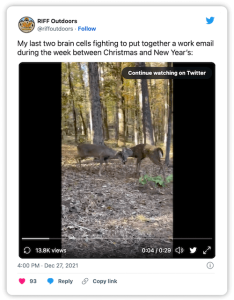
McElwee once again emphasises the importance of being where shoppers are rather than where the brand wants them to be. “You know, you’ll see a lot of CPG brands who don’t really want to play on marketplaces like Amazon… but the reality is the Amazons of this world aren’t going to go away, in fact they’re going to open in more markets.”
“We focused a lot last year on developing digital IQ, because what often happens in businesses like ours – especially with digital being very new to CPG companies – the digital IQ of the organisation is almost inversely proportional to the leadership of the organisation.”
Towards the end of 2020, McElwee was recorded in conversation with Good Growth’s Dan Kendall as part of a new series of The Good Growth podcast. McElwee has since moved on from Kelloggs to join Stanley Black & Decker, but the conversation touches on a particularly interesting brand campaign from Kelloggs, as well as insight from McElwee’s work in different marketplaces, and his opinion on the importance of personalisation in ecommerce.
The rising importance of digital and ecommerce
“I think what the pandemic has allowed – or forced – us to do is that brands have had to look at… their current touchpoints versus the touchpoints that they should be going after.” says McElwee. “I think digital plays a big part of that.”
For retail businesses in particular, this also means an evolution of the media mix.
Dean McElwee has a wealth of experience working within ecommerce for global brands, including Coca Cola and MasterCard, and most recently, as executive director for Kelloggs.
McElwee explains how the organisation has embraced this fact, launching its first ever campaign for Pringles on TikTok in 2020.
Legacy brands embracing new platforms
“Leadership of the organisation, having spent a long time there – it’s not natural for them. They’re not the millennials and the guys coming through who don’t know anything different than growing up with things like TikTok and Snapchat. It’s ingrained.”
This means that digital initiatives (as well as broader business aspirations) are not properly aligned with digital investment in the right places.
“I think with all these choices that we have in the digital landscape, first of all you’ve got a huge opportunity to get data, and getting data enables you to make better decisions than you did before – not work as much as you did on gut or feeling. So, focus really on building a platform of data driven marketing as our first step. That allows us to then decide where we want to be – and engage where we want to be – to proactively shape that future rather than have it happen to us.’
Kendall and McElwee touch on the role that digital and ecommerce now plays for brands, and how brands are being forced to re-think strategy – particularly since Covid-19.
But as McElwee explains, the decision turned out to be a success, and the reaction to the campaign was far bigger than expected. “We had about 150,000 user generated content videos, and we ended up with about 2.5 billion views on the hashtag #playwithpringles,” he says.
While it’s easy for brands to say they want to become more focused on customers, becoming truly ‘customer-centric’ can be difficult to do, but McElwee suggests that Covid-19 has forced organisations to make changes.
Developing digital IQ
You can subscribe to The Good Growth Podcast on Spotify, or explore all episodes via the Good Growth website.
“They opened in the Netherlands and Sweden last year, they’ll open in Poland this year… You need to be where those shoppers are and really try to win at those points of purchase.”
You can listen through the embedded Spotify widget at the end of this article, or read on for some selected highlights.
“Often we’ve planned our business models in terms of – it’s a retail business so we will do an advert on TV, we may do some sampling in-store. We’ve had to reassess those, and I think putting the consumer back at the centre of that is really what we’ve got to do. We’ve got to look at all those digital touchpoints.”
For retail brands, says McElwee, this means recognising “that ecommerce and digital isn’t a project that somebody does on the side.” Rather, “it needs to be ingrained in the processes of how we work as a business. So, we need to be involved in the decision-making that happens, you need to change the budget allocation processes and the decisions you’re making.”
“Often as big brands we try to focus through our digital channels and things like that, but we’ve got to meet them where they are rather than where we want them to be – and be a part of their lives rather than asking them to be a part of our lives.”
Meeting shoppers where they are
“For a brand like ours – more than a 100-year old company – the first time somebody mentioned TikTok, you can imagine the kind of reaction…”
The campaign – which involved influencers from different markets – encouraged users get creative with the iconic Pringles tube through fashion and dance. McElwee suggests that its success is partly due its alignment with the creative and self-expressive style of content that consumers are already enjoying on TikTok.
Another important element on being customer-centric is people and culture, and as McElwee says, “capability”.
For a legacy brand like Kelloggs, becoming more ‘customer-centric’ means embracing where customers are now spending their time, which is increasingly social media platforms like Snapchat and TikTok. When asked about priorities for Kelloggs, McElwee says that this is “to really get scaled on data-driven marketing.”


